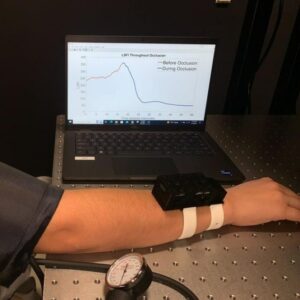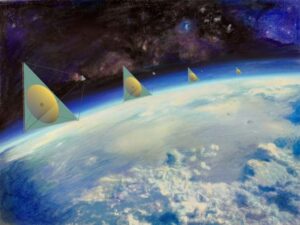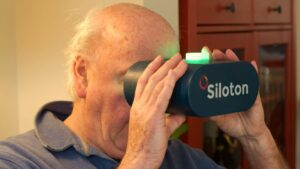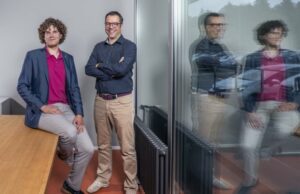Building quantum computers isn’t just about developing clever new hardware. Toby Cubitt, who co-founded the quantum-tech firm Phasecraft, tells Hamish Johnston why algorithms are vital too

Quantum computers show great promise because they could, at least in principle, solve certain problems that cannot be cracked even by the most powerful conventional supercomputers. But building quantum bits, or qubits – and linking them to create practical quantum computers – is a huge challenge. In particular, quantum computers are incredibly noisy, which quickly introduces errors into quantum calculations.
That’s why many researchers are developing clever quantum algorithms that can do useful calculations even on today’s small, noisy quantum computers. One company contributing to that effort is Phasecraft, which was spun off from University College London and the University of Bristol in 2019. The physicist Toby Cubitt, co-founder and chief technology officer at Phasecraft, talks to Hamish Johnston about how real-world applications could be just around the corner.
Why did you originally set up Phasecraft?
We founded Phasecraft because quantum computing was reaching the point where quantum-computing hardware was no longer just a toy system, but pushing the boundaries of what could be done on conventional computers. We wanted to try to develop the algorithms needed to make use of that early-stage hardware and make quantum applications a reality. That’s a huge challenge scientifically, but a fascinating one to be involved in.
How big is the company at the moment?
We currently have about 20 full-time staff, roughly a third of whom have a background in quantum computing or quantum information theory, a third in materials science, condensed matter and chemistry, and a third on the computing side. They all have a knowledge of quantum computing, but are also very, very good at – and love – programming this stuff, and implementing it, and getting it working on the hardware.
We sponsor PhD students who are at places like University College London and the University of Bristol but who work directly here in the company’s offices. We also have lots of interns – both undergraduates and PhD students. We’re very focused on research and development at the moment. But as useful applications come online, I expect things to become much more commercial in nature.
Would you say quantum software has been ignored in favour of all the hype and excitement of developing new qubits and processor technologies?
Hardware is extremely important and deserves the attention it’s been given, involving as it does some fascinating physics, materials science and engineering. But for us on the software side, it’s all about coming up with clever mathematical ideas to make algorithms more efficient and work on today’s early-stage, small-scale quantum devices. In fact, we’re more likely to make progress through better algorithms than by waiting for improvements in hardware.
Even if quantum hardware grew exponentially, it could be a decade before you could do anything useful with it. Working on algorithms also doesn’t require expensive cryostats, dilution refrigerators, liquid helium or chips – just a bunch of really smart people thinking deeply, which is what we have at Phasecraft. A few years ago, for example, we developed algorithms for simulating the time dynamics of quantum systems that were about six orders of magnitude better than those from Google and Microsoft.
Quantum processors are noisy, which means they quickly lose coherence and make calculations impossible. How do you develop practical algorithms to run on imperfect devices?
Noise and errors are the bane of all quantum applications on real hardware. There have been some incredible improvements to hardware, but we can’t assume quantum computers are perfect, as we can with classical devices. So with everything we do in Phasecraft, we have to think in terms of imperfect, noisy quantum computers that have errors. Run any computation and the errors build up so fast that you’re just getting noise – random data – out, and you’ve lost all of the quantum information.
To get round this problem, it’s critical to make algorithms as efficient as possible and make them less sensitive or susceptible to noise. It’s true that in the 1990s Peter Shor developed the concept of quantum error correction and the fault-tolerant threshold theorem, which shows, theoretically, that even on noisy quantum computers, you can run arbitrarily long quantum computation calculations. But that requires such huge numbers of qubits that we can’t count on this as a solution.

Our focus is therefore more an engineering-type problem, where we try to understand what noise looks like in detail. The better we can understand noise, the more we can design around it so it doesn’t affect the outcome. But there’s a big payoff because if you can make an algorithm less complex, you can get something useful out of these noisy quantum computers. It’s a question of designing the algorithms so we can squeeze more out of them.
I often say that today’s quantum computers are where classical computers were in the 1950s. Back then, people like Alan Turing were coming up with really clever ideas of how to squeeze a bit more out of clunky primitive hardware and actually do incredible things with it. That’s the stage we’re at with quantum computing. In fact, certain algorithms are sometimes more suited for one type of hardware than another.
In terms of hardware, what type of qubits are you using at the moment?
At Phasecraft we’re interested in all types of hardware. Predominantly, though, we’re using superconducting qubit circuits, because that’s the current leading hardware platform. But we’re running ion traps on cold-atom hardware too and we’re also thinking about photonic hardware. But we’re not tied to one particular platform.
Phasecraft’s focus is on algorithms that calculate material properties. Why are those applications so suitable for today’s early quantum computers?
In industry, many companies spend a lot of time and money using classical, high-performance computers to work out the properties of materials. The trouble is, it’s very computationally intensive so they end up trying to simplify the problem. But the danger then is you can get things completely wrong. For example, you may end up predicting a material is an insulator when in fact it’s a conductor. It can be that level of wrong sometimes.
At Phasecraft, we’re focusing on modelling and simulating materials because those applications are within closest reach of current hardware. Other applications, such as optimization, are more demanding in terms of the number of qubits and gates you need. As hardware improves, quantum chemistry simulations will become within our reach. They’re harder to simulate than periodic, crystalline materials because the complexity of an algorithm in molecular systems scales as number of electron orbitals to the power of four.
Can you give us a taste of some specific materials you’ve looked at?
At the moment, the hardware is not yet large enough to be able to do simulations of real materials beyond what can be done classically. So we’re still at the stage where we have the algorithms, but we don’t yet quite have the hardware to run on, although it’s getting close. Having said that, the types of materials that are good targets for early-stage applications of quantum computing are clean-energy-related – battery materials, things like metal oxides.
They also happen to be ones where classical algorithms don’t work very well, because they involve strongly correlated electrons. The same goes for photovoltaics. In fact, we have a collaboration with Oxford PV, which is working with perovskite photovoltaics, where we’re again looking at strongly correlated electron systems. This involves dynamically simulating things like the rate at which particle-hole pairs recombine to emit light.
We’ve also examined strontium vanadate, which happens to have a nice band structure that means that it can fit on a smaller quantum computer than certain other materials. It’s not the smallest, but it’s a metal-oxide system that’s of interest and needs fewer qubits and fewer gates than other metal oxides.
When do you think Phasecraft will reach the point of “quantum advantage” where your algorithms can run on a quantum processor and can calculate things a supercomputer can’t?
That’s the million-dollar question. In fact, it’s probably the billion-dollar question. The quantum industry needs to get to that point where it’s not just demonstrating toy problems but solving real-world problems on quantum computers.
I hope I don’t sound like the guy who supposedly once said there’d only ever be a need for three computers in the world, but I genuinely think we might get there in the next two to three years. Those early questions may be of scientific interest rather than industrial interest – industry might be a little beyond that point. It’s not going to be a case of switching off your high-performance computing (HPC) clusters overnight and moving straight over to a quantum computer. It’s much more likely to be a gradual process whereby more and more useful things will come online. It’s how science works: you make progress, you hit an obstacle and then make more progress. It tends to ratchet up.
Progress depends on lots of hard work by large teams of scientists working diligently for many years. That’s what’s going on in quantum computing, and the first applications might not hit the headlines
When the wider media report on quantum computers, they tend to assume massive breakthroughs emerge out of the blue from nowhere. But they don’t. Progress depends on lots of hard work by large teams of scientists working diligently for many years. That’s what’s going on in quantum computing, and the first applications might not hit the headlines. But scientists will realize when we’ve passed that threshold where you can do things that are impossible with conventional computers. We’re not far off.
Phasecraft recently received £13m in private funding. What do you plan to do with that cash?
For a quantum algorithm company like ours, the vast majority of funding goes on paying people’s salaries. Our staff are the key – our most valuable asset is our team. For a hardware company it’s very different, because hardware is expensive. But we need people to think and code so that money will let us steadily expand our team.
We’ve always got more ideas than we have the resources to pursue and, as we get closer to implementing large computations on quantum computers, we’ll be scaling up the team. It’s still a few years before we will have commercially relevant applications, but when that happens, we’ll go through an inflection point and the whole industry will change. We are always keen to talk to smart people who are excited about using quantum mechanics for real-world applications.
So how will the firm evolve?
All it takes is one amazing, outstanding idea that could completely change the whole quantum industry. We’re keen on making sure we give our research team the space to do that kind of blue-sky thinking that could change the face of where the company goes. Sure, not all ideas will work – 20 might fail but the 21st will turn out to be a significant new direction that no-one else thought of. That’s happened a couple of times at Phasecraft already. Someone gets inspired, and then a new direction opens up.

Quantum algorithms make clever use of noisy hardware
We’re at a hugely exciting time in quantum computing. I’m still a professor at UCL, and I still have an academic group there, but I find both sides – applied and theoretical – equally intellectually interesting. I’ve theorized about some topics for 20 years but haven’t had any tools to put them into practice. Now, though, I can take that theory and make it real. Instead of just writing a paper, I can run my idea on hardware.
Sure, it might not work at all. It could turn out that the real universe says: “No. That’s not a good idea.” But it could still be an incredibly useful and fascinating problem to tackle. And so the applied side of the research – applying this physics to the technology – I find just as fascinating and interesting as the blue-sky academic thinking.
- SEO Powered Content & PR Distribution. Get Amplified Today.
- PlatoData.Network Vertical Generative Ai. Empower Yourself. Access Here.
- PlatoAiStream. Web3 Intelligence. Knowledge Amplified. Access Here.
- PlatoESG. Carbon, CleanTech, Energy, Environment, Solar, Waste Management. Access Here.
- PlatoHealth. Biotech and Clinical Trials Intelligence. Access Here.
- Source: https://physicsworld.com/a/toby-cubitt-why-algorithms-will-speed-up-applications-of-quantum-computers/
- :has
- :is
- :not
- :where
- $UP
- 160
- 20
- 20 years
- 2019
- 21st
- 90
- a
- Able
- About
- ABSTRACT
- AC
- academic
- actually
- affect
- again
- ago
- algorithm
- algorithms
- All
- already
- also
- Although
- always
- amazing
- an
- and
- Another
- any
- anything
- applications
- applied
- Applying
- ARE
- around
- AS
- asset
- assume
- At
- attention
- back
- background
- BAND
- battery
- BE
- because
- become
- been
- before
- Better
- Beyond
- Big
- Bit
- Blue
- both
- Both Sides
- boundaries
- breakthroughs
- bristol
- build
- Building
- Bunch
- but
- by
- calculate
- CAN
- Can Get
- cannot
- case
- Cash
- centre
- certain
- challenge
- change
- chemistry
- chief
- chief technology officer
- Chips
- click
- Close
- closer
- Co-founder
- code
- College
- come
- coming
- commercial
- commercially
- Companies
- company
- Company’s
- completely
- complex
- complexity
- computation
- computations
- computer
- computers
- computing
- concept
- Condensed matter
- conductor
- contributing
- conventional
- Corner
- correlated
- could
- Couple
- cracked
- create
- critical
- Current
- Currently
- cyberspace
- DANGER
- data
- decade
- demanding
- demonstrating
- depends
- deserves
- Design
- designing
- detail
- develop
- developed
- developing
- Development
- Devices
- DID
- different
- digits
- diligently
- dilution
- direction
- directly
- do
- does
- Doesn’t
- done
- Dont
- dynamically
- dynamics
- Early
- early stage
- efficient
- effort
- electrons
- else
- emerge
- end
- Engineering
- enough
- equally
- error
- Errors
- Even
- EVER
- everything
- evolve
- example
- excited
- Excitement
- exciting
- Expand
- expect
- expensive
- exponentially
- extremely
- Face
- fact
- FAIL
- far
- fascinating
- FAST
- few
- fewer
- Find
- Firm
- First
- fit
- Focus
- focused
- focusing
- For
- Founded
- four
- from
- front
- funding
- futuristic
- Gates
- genuinely
- get
- getting
- Give
- given
- Go
- Goes
- going
- good
- got
- gradual
- great
- grew
- Guy
- had
- happen
- happened
- happens
- Hard
- hard work
- harder
- Hardware
- Have
- having
- Headlines
- helium
- here
- high-performance
- Hit
- hope
- How
- How To
- hpc
- HTML
- HTTPS
- huge
- Hugely
- Hype
- i
- idea
- ideas
- if
- image
- implementing
- important
- impossible
- improvements
- improves
- in
- incredible
- incredibly
- industrial
- industry
- Inflection
- Inflection Point
- information
- inspired
- instead
- interest
- interested
- interesting
- into
- Introduces
- involve
- involved
- involves
- involving
- issue
- IT
- John
- jpg
- just
- Keen
- Key
- Kind
- knowledge
- large
- leading
- least
- left
- less
- let
- Level
- light
- like
- likely
- linking
- Liquid
- List
- little
- London
- Long
- longer
- looked
- looking
- LOOKS
- lose
- lost
- Lot
- lots
- love
- Majority
- make
- Making
- many
- massive
- material
- materials
- mathematical
- Matrix
- Matter
- max-width
- May..
- means
- mechanics
- Media
- Men
- metal
- Microsoft
- might
- MIT
- modelling
- molecular
- moment
- money
- more
- more efficient
- most
- moving
- much
- my
- Nature
- Need
- needed
- needs
- New
- new hardware
- next
- nice
- no
- Noise
- now
- number
- numbers
- obstacle
- of
- off
- Officer
- offices
- often
- Old
- on
- once
- ONE
- ones
- online
- only
- open
- opens
- optimization
- or
- orders
- originally
- Other
- our
- out
- Outcome
- outstanding
- over
- overnight
- Oxford
- pairs
- Paper
- particular
- passed
- paying
- People
- people’s
- perfect
- periodic
- phd
- Physics
- Physics World
- Places
- plan
- platform
- plato
- Plato Data Intelligence
- PlatoData
- Point
- possible
- power
- powerful
- Practical
- Practical Applications
- practice
- predicting
- predominantly
- primitive
- principle
- private
- probably
- Problem
- problems
- process
- Processor
- processors
- Professor
- Programming
- Progress
- promise
- properties
- pursue
- Pushing
- put
- Quantum
- quantum algorithms
- Quantum Computer
- quantum computers
- quantum computing
- quantum error correction
- quantum information
- Quantum Mechanics
- quantum software
- quantum systems
- Qubit
- qubits
- question
- Questions
- quickly
- quite
- random
- Rate
- rather
- reach
- reaching
- real
- real world
- Reality
- realize
- really
- received
- recently
- relevant
- report
- require
- requires
- research
- research and development
- researchers
- Resources
- right
- roughly
- round
- Run
- running
- Said
- salaries
- same
- say
- says
- scales
- scaling
- Science
- scientific
- scientists
- sensitive
- set
- show
- Shows
- side
- Sides
- significant
- simplify
- SIX
- small
- smaller
- smart
- So
- Software
- solution
- SOLVE
- Solving
- some
- Someone
- something
- sometimes
- Sound
- Space
- specific
- speed
- spend
- sponsor
- spun
- Squeeze
- Staff
- Stage
- Start-up
- steadily
- Steps
- Still
- STONE
- straight
- strongly
- structure
- Students
- such
- suitable
- supercomputer
- supercomputers
- sure
- susceptible
- system
- Systems
- tackle
- Take
- takes
- Talk
- Talks
- targets
- taste
- team
- teams
- Technologies
- Technology
- tells
- tend
- tends
- terms
- than
- that
- The
- the world
- Them
- then
- theoretical
- theory
- There.
- therefore
- These
- they
- things
- think
- Thinking
- Third
- this
- those
- though?
- thought
- three
- threshold
- Through
- thumbnail
- Tied
- time
- times
- to
- today’s
- too
- tools
- Topics
- toy
- traps
- trouble
- true
- try
- trying
- TURN
- two
- type
- types
- Uk
- understand
- Universe
- university
- us
- use
- using
- Valuable
- Vast
- very
- vital
- Waiting
- wanted
- was
- we
- WELL
- were
- What
- when
- which
- WHO
- whole
- whom
- why
- wider
- Wikipedia
- will
- with
- within
- Work
- work out
- working
- works
- world
- writing
- Wrong
- years
- yet
- you
- Your
- zephyrnet












